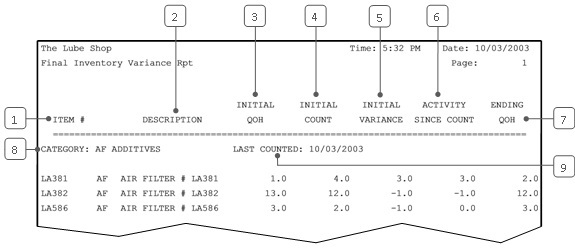The Final Inventory Variance Report is a follow-up to the Inventory Variance Report. It documents all inventory items with count discrepancies over the last six days. Like the Inventory Variance Report, it gives both the system and physical counts and shows the variance. In addition, this report shows any adjustments made to the count of items at variance, as well as the ending quantity on hand, as of the time the report is printed. Using this report, you can tell whether action was taken to correct the counts for items at variance.
Use the following steps to set up and submit a Final Inventory Variance Report:
| Field | Definition | ||
|---|---|---|---|
| Category | Select a particular category if you want to limit the information on the report. Leave blank to print all categories. | ||
| Print Time on Report | Printing the time helps you identify the most current report when the same report is printed more than once during a day. This field defaults to Y to print the time on the report. If you do not want the time to print on a report, type N. We recommend that you always print the time on a report. | ||
| Duplex | This field appears for terminals that have report type 2 enabled in the Set Up Printer Controls screen. Duplex mode enables printing on both sides of the paper.
|
||
| Landscape | This field appears for terminals that have report type 2 enabled in the Set Up Printer Controls screen. It prints horizontally on the paper. | ||
| Number of Printed Lines per Page | This value tells the computer how many lines to print on each page of the report. A typical 11-inch page can contain up to 66 lines, but this field defaults to 60 to allow three-line margins at the top and bottom of the page.
|
||
| Total Number of Lines per Page | This field indicates the length of the paper in the printer. A typical 11-inch page contains 66 lines. Your system interprets a 0 or 66 in this field to mean that standard 11-inch paper is loaded in the printer. Because a 66 causes a form feed to take more time, accepting the default, 0, is recommended. | ||
| Print Report To | This field tells the computer where to send the report. The following list contains the different selections available for this field.
|
||
| Command Line Options | The line at the bottom of the screen contains commands to print the report and to save or change the report settings.
|
You can set up this report to print for the last six days during the daily, weekly, or monthly closing process.

| Callout | Item | Description |
|---|---|---|
| 1 | Item # | Identification number of the inventory item. |
| 2 | Description | Description of the inventory item. |
| 3 | Initial QOH | Initial quantity on hand of the item according to your system. |
| 4 | Initial Count | First count value entered. (This is the initial count, not a corrected value.) |
| 5 | Initial Variance | The difference between the initial physical count and the initial system count.
Initial Variance = Initial Count – Initial QOH |
| 6 | Activity Since Count | Inventory adjustments made since the count was taken. |
| 7 | Ending QOH | Ending quantity on hand for the item. This is the quantity computed by the system at the time of the report, including adjustments, as well as all other activity since the inventory count. |
| 8 | Category | Category code and description. |
| 9 | Last Counted | Date the last physical count was made and entered into the system for the category. |
This report is a follow-up to the Inventory Variance Report, which prints automatically after counts are entered. You should print this report manually at the end of inventory procedures. Use it to monitor adjustments and accuracy. Be on the lookout for large corrections to inventory, which may indicate shrinkage. You can print this report automatically at the end of each month, but you should remember that it will only print counts for the last six days of the month.